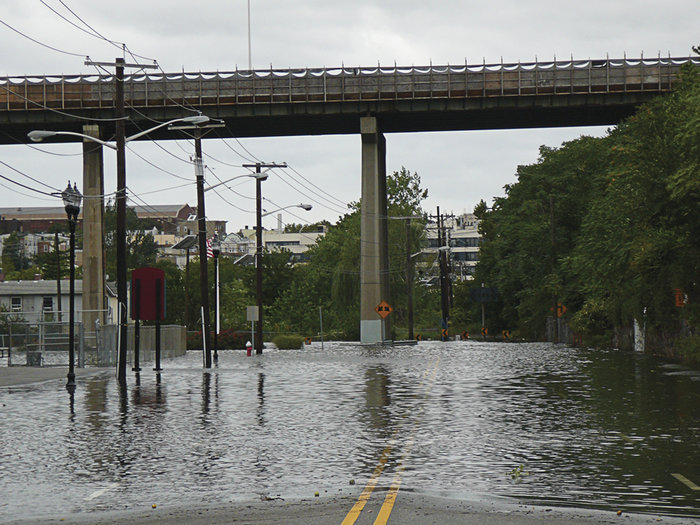While summer makes its unofficial exit this weekend, the 2012 hurricane season is still in full force and won’t end until Nov. 30.
Last August, the much anticipated Hurricane Irene was downgraded to a tropical storm by the time it hit Hudson County, but still managed to drop between six to eight inches of rain and force the evacuations of low-lying neighborhoods in Jersey City, Hoboken, and New York City.
For government leaders, Irene was the first opportunity to implement emergency plans that were put in place following the terrorist attacks of 2001 and 2005’s Hurricane Katrina.
In the weeks following Irene, Jersey City residents were both complimentary and critical of the city’s preparedness operations. Many believe Irene exposed both strengths and weaknesses in state and local emergency management systems, some of which have been re-examined in light of lessons learned last year.
Expanded capabilities
Jersey City opened seven shelters during Hurricane Irene, including one that was specifically set aside to house pet owners and their animals. (The lack of pet-friendly shelters in New Orleans during Hurricane Katrina was among the reasons some residents did not evacuate during that crisis.)
These shelters had the capacity to protect as many as 2,500 Jersey City residents and about 500 people took advantage of these shelters during Irene.
Greg Kierce, the director of Jersey City’s Office of Emergency Management and Homeland Security, said the city has fine-tuned some of its preparedness plans as a result of lessons learned during Hurricane Irene.
‘We’ve expanded our capabilities over the year.’ – Greg Kierce.
____________
He said that by dealing with locally-based businesses, the city was able to provide water, meals, and other necessities to people who stayed in the city’s seven shelters. The newly created logistical support center, Kierce said, has enough “ready meals” and other supplies to care for more than 2,000 people for three days. Irene taught the city that “for the first 72 hours, you’re own your own,” he said.
He also emphasized the need for residents to develop their own emergency preparedness plans for their families and households. Kierce said municipal emergency personnel might be too busy or preoccupied to assist every resident who needs help.
“We have to prioritize what we can do,” said Kierce.
Communication gap
In the days after Hurricane Irene moved through the area, the Reporter interviewed several residents about their experiences during the storm. Many people praised the city for opening shelter space, and for having a pet-friendly shelter available. But residents seemed to be most critical of the ways in which the city attempted to communicate with people in the hours before Irene arrived.
Most municipalities have implemented what are known as “reverse 911” systems to automatically notify residents by text, e-mail, or phone when there is an emergency situation in the city. Jersey City has such a system, but several residents last year said it leaves much to be desired.
On Aug. 27, just hours before Irene was expected to hit the New York area, Jersey City issued a mandatory evacuation of several low-lying neighborhoods that have a history of flooding. Limited voluntary evacuations had been recommended earlier. These recommendations and orders came in the form of press advisories to the local media, postings made to the city website, Twitter messages, postings to the city’s Facebook page, and C3Alerts through the city’s reverse 911 system.
Some of those who were interviewed, however, questioned the heavy reliance on social media to stay in contact with residents, particularly the elderly, who are less adept at using such tools as Twitter or Facebook. Many residents, even those who are savvy with social media, said they had never heard of the C3 Alert system and some said the system worked inconsistently at best.
Downtown resident Beth Tenant, who decided to evacuate from her Fourth Street apartment during Irene, said she actually had to piece together information from various sources to determine whether she should stay or go.
Another resident, Rob Ducket, said he found some of the information put out by the city to be confusing.
When asked last week whether the city has made any changes to its communication systems in light of some of these complaints, Kierce said, “I dispute anyone who says that they didn’t receive notification [of the evacuations].”
The C3 Alert system, he added, experienced a “50 to 60 percent increase in usage” during Irene.
No modifications have been made to the city’s communication operations, Kierce said.
2012 outlook
Nationally, Hurricane Irene led to at least 45 deaths and caused $7.3 billion in property damage along the Atlantic coast. Irene, which led to several other deaths in the Caribbean, became the fifth most expensive U.S. hurricane on record.
Forecasters at the National Oceanic and Atmospheric Administration have predicted a relatively mild hurricane season for this year. Still, there could be up to 17 named storms, about five to seven of which could potentially develop into hurricanes.
As many as three of these hurricanes could reach Category 3 status – meaning they pack wind gusts of 111 miles per hour or more – and are expected to primarily impact the southern coastal region of the U.S.
To register for Jersey City’s C3 Alert system, visit https://my.c3alert.us/jerseycitynj/home/welcome.
E-mail E. Assata Wright at awright@hudsonreporter.com.
